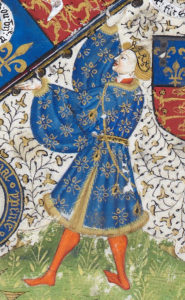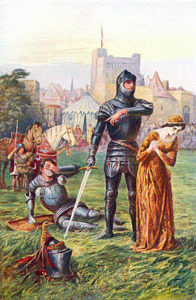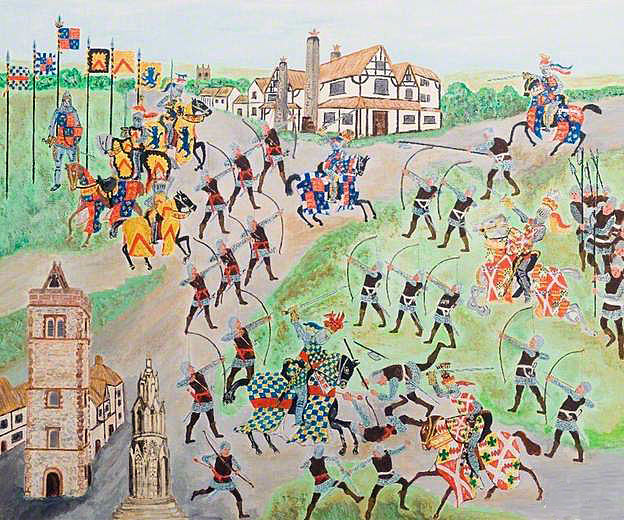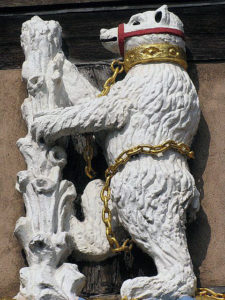The First Battle of the Wars of the Roses, fought in the streets of St Albans on 22nd May 1455
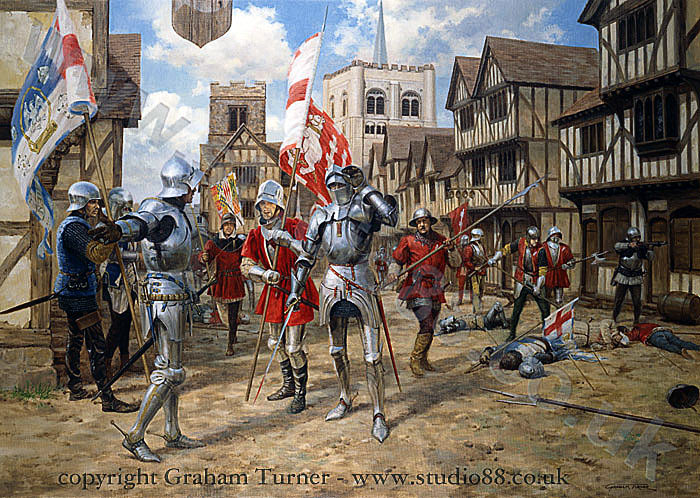
First Battle of St Albans, fought on 22nd May 1455 in the Wars of the Roses: picture by Graham Turner
The previous battle of the Hundred Years War is the Battle of Castillon
The next battle of the Wars of the Roses is the Battle of Blore Heath
to the Wars of the Roses Index
Battle: First Battle of St Albans
War: Wars of the Roses
Date of the First Battle of St Albans: 22nd May 1455
Place of the First Battle of St Albans: In the streets of the City of St Albans in Hertfordshire.
Combatants at the First Battle of St Albans: Yorkist rebels against the Lancastrian King Henry VI.
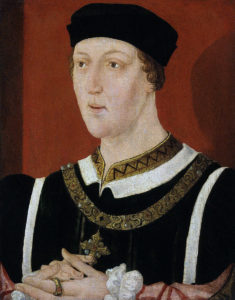
King Henry VI, Lancastrian king at the First Battle of St Albans, fought on 22nd May 1455 in the Wars of the Roses
Commanders at the First Battle of St Albans: Richard, Duke of York, commanded the Yorkist army, with Richard, Earl of Salisbury (York’s brother-in-law) and Richard, Earl of Warwick (Salisbury’s son).
King Henry VI commanded the Lancastrian Royal army, with his close supporters the Dukes of Somerset and Buckingham, appointed Constable of England before the battle and the Earls of Pembroke, Northumberland and Devon.
Size of the armies at the First Battle of St Albans: The Yorkist army comprised some 3,000 knights, men-at-arms and archers. The King’s army comprised some 2,000 men.
Winner of the First Battle of St Albans: The Yorkists defeated the King’s army, capturing the King himself.
Uniforms, arms and equipment at the First Battle of St Albans: The senior commanders and their noble supporters and knights rode to battle on horseback in armour, with sword, lance and shield, but often, as at the First Battle of St Albans, fought on foot.
Their immediate entourage comprised mounted men-at-arms, in armour and armed with sword, lance and shield, although often fighting on foot.
Because the battle took place along the lanes and streets of St Albans and was fought over street barricades, all combatants were on foot.
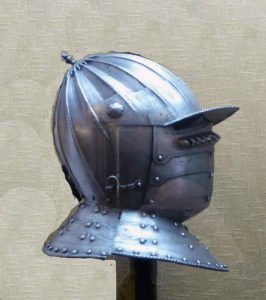
Helmet in the Wallace Collection: First Battle of St Albans, fought on 22nd May 1455 in the Wars of the Roses
The Yorkist army included a powerful force of longbowmen, led by Sir Robert Ogle, a veteran of the war in France.
Handheld Firearms were beginning to appear in numbers on the battlefield, but were still cumbersome, unreliable and difficult to use. None appear to have been used at the First Battle of St Albans.
Artillery, although widely used in warfare, was still too heavy, cumbersome and difficult to move and fire, to be used on the battlefield, as opposed to siege warfare. None were used at the First Battle of St Albans.
The end of the Hundred Years War caused many hundreds of English and Welsh men-at-arms and archers to return to their home countries from France. The wealthier English and Welsh nobles were able to recruit from these veterans, companies of disciplined armed retainers, forming the backbone of their field armies.
A major difference between the armies at the First Battle of St Albans was that the Duke of York, with his confederates the Dukes of Warwick and Salisbury prepared their forces on their estates in the North of England for some months before marching south to confront King Henry VI, in their plan to remove and execute their enemy the Duke of Somerset.
The King was surprised by this threat and his army was not prepared for battle.
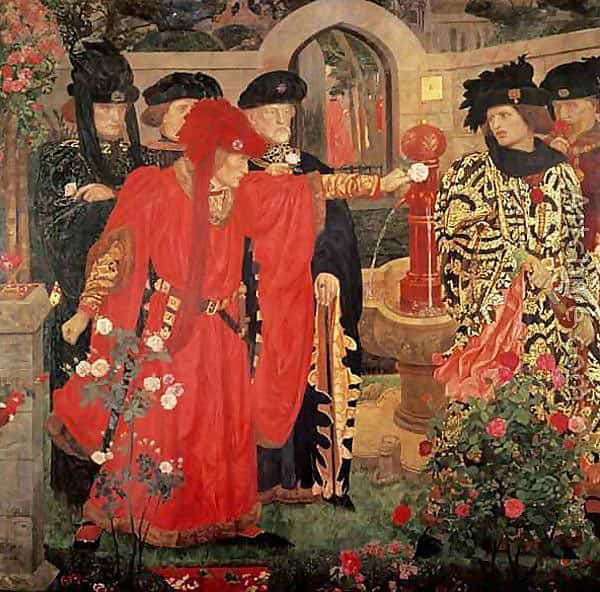
Yorkists and Lancastrians taking white and red roses in the Inner Temple Garden: First Battle of St Albans, fought on 22nd May 1455 in the Wars of the Roses: allegorical picture from William Shakespeare by Henry Arthur Payne
Background to the First Battle of St Albans: King Henry VI came to the throne of England in 1422, at the age of one, on the death of his father, King Henry V. His reign saw English fortunes in France collapse and the Hundred Years War draw to a disastrous close, with England’s possessions in France, other than Calais, captured by the French king.
Henry VI and his wife Queen Margaret ruled with a number of advisers of limited competence, while the Yorkists brought pressure for their removal.
The King’s most influential adviser was the Duke of Somerset, a Lancastrian claimant to the English throne, in the event that King Henry VI died without male heir.
The leader of the Yorkist cause was Richard, Duke of York, another nobleman with a strong claim to the English throne.
A fierce antipathy and rivalry existed between the Dukes of Somerset and York, a major cause for the outbreak of the Wars of the Roses.
In 1453, Queen Margaret produced a son and heir to the throne, Prince Edward.
In 1454, King Henry VI suffered an extended period of insanity and the Duke of York was appointed regent. York seized the opportunity to remove Somerset from his posts.
At the end of the year, Henry recovered and, in his turn, York was removed from his posts and replaced by Somerset.
In May 1455, the Duke of York, accompanied by the Earls of Salisbury and Warwick, marched south with an armed force to confront the King and the Duke of Somerset.
The King and his advisers were taken by surprise by the news of York’s approach. The King’s army was an assemblage of nobles, few of whom actively supported the Duke of Somerset and their retinues, far from a homogenous military force. They were not prepared for battle, as the Yorkists were.
In particular the King did not have a contingent of longbowmen to counter the Yorkist archers led by Sir Robert Ogle.
The King marched his army out of London, fearing that York attracted too much support in the capital and advanced to the Hertfordshire city of St Albans. The hope among his advisers was that the threat from the Yorkists could be settled by negotiation and active hostilities avoided.
In the meantime, urgent summonses were sent to nobles and authorities across the country to send forces to meet the King at St Albans.
Substantial reinforcements were dispatched but arrived too late for the battle.
———————————-
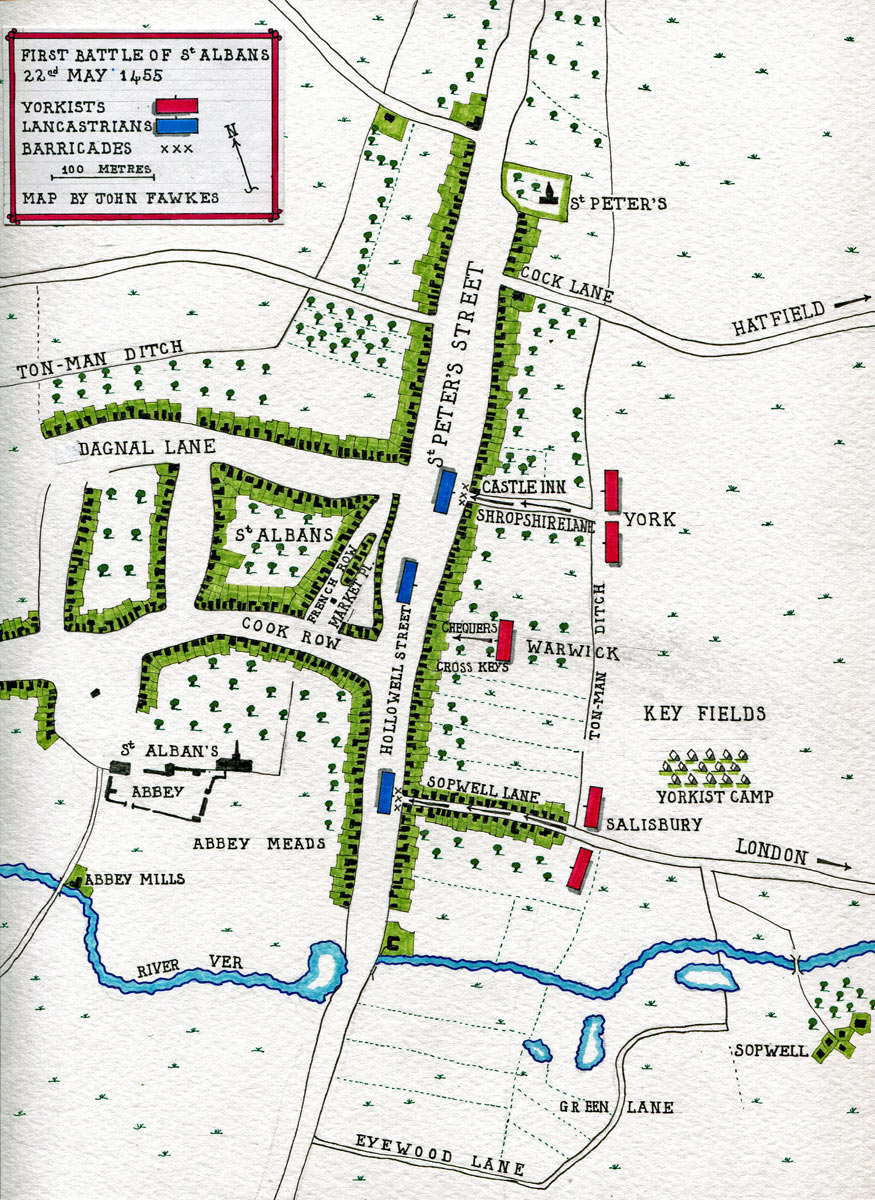
Map of the the First Battle of St Albans, fought on 22nd May 1455 in the Wars of the Roses: map by John Fawkes
Account of the First Battle of St Albans: On 20th May 1455, the Yorkist force reached Royston, from where the Duke of York wrote to the Lord Chancellor and the King in London, requiring that the Duke of Somerset be removed from his posts.
By this time, aware of the Duke of York’s advance from the North and his hostile intentions, King Henry VI’s army, now commanded by the Duke of Buckingham, was advancing to meet the Yorkists.
It was far from clear that hostilities were inevitable and communications were exchanged between the rival armies.
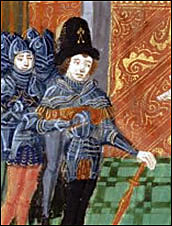
Edmund Beaufort, Second Duke of Somerset: First Battle of St Albans, fought on 22nd May 1455 in the Wars of the Roses
The King’s force arrived in St Albans on the morning of 22nd May 1455 and barricades were built in Hollowell Street, blocking the two main roads from the east, the direction of the Yorkist advance towards the city.
The Royalist troops defending the two barricades were commanded by Lord Clifford.
The Yorkist army appeared to the east of St Albans, also early on 22nd May 1455 and encamped in the Key Fields.
Negotiations were opened between the factions, heralds riding back and forth with messages. The Yorkists required the surrender of the Duke of Somerset for trial and, by implication, execution. The King’s messages demanded that the Yorkists give up their armed threat and return to their fealty to the King.
Around mid-morning the Duke of York resolved to attack, before the King could receive the substantial re-inforcements that were expected.
The Yorkists launched assaults on the two barricades. The Duke of York led the force that advanced up Shropshire Lane. The Earl of Salisbury attacked the barricade at the end of Sopwell Lane.
The lanes were narrow and the King’s men held off both attacks.
The reserve, that included Sir Robert Ogle’s 500 longbowmen was commanded by the Earl of Warwick.
Warwick’s men crossed the Ton-Men Ditch, mid-way between the two lanes, made their way to the line of buildings along Hollowell Street and broke through into Hollowell Street, at a point between the Chequers and Cross Keys Inns, on the flanks of the barricades, one to their right and one to the left.
The Yorkist archers opened a devastating fire on the Royal troops on the barricades and assembled in the area of the Market Place.
It was effectively the end for the King’s army.
The Royal troops left the barricades and escaped into the town, enabling the main bodies of Yorkists to pass the barricades and break into the town centre.
The King, with his standard and bodyguard, were positioned in St Peter’s Street around the Castle Inn. Yorkist archers shot down many of the King’s party and an arrow injured the King in the face.
Several of the Royalist commanders were killed in the street fighting, Lord Clifford among them.
As the fighting drew to a close, the Duke of York found King Henry VI, taking refuge in a chapel of St Albans Church, but made it clear that he still considered himself a loyal subject.
Somerset, knowing that the Duke of York was after his life, fought his way out of the Castle Inn and died fighting in the street.
The whole battle probably lasted under an hour.
The Yorkist troops pillaged the town until finally restrained.
Note: Seymour describes the initial two assaults by the Yorkist columns as being against barricades put up at the junctions of the two lanes, Shropshire Lane and Sopwell Lane, with Hollowell Street. Other authorities, including Burley, Elliott and Watson, have the initial engagement at the entry points across the Ton-Man Ditch. It would seem more likely that the barricades were positioned as described by Seymour. The King’s army had little time to prepare defences and it would have been easier to assemble the barricades at the town entrances to the lanes. In addition, it makes little sense for Warwick’s men to cross the open land and force their way into Hollowell Street, if the main points of defence were on the Ton-Man Ditch, behind them. If that was the case, Warwick’s men would have crossed the ditch, turned to each flank and attacked the Lancastrians at the barriers, with no need to force their way into Hollowell Street, as clearly happened.
Casualties at the First Battle of St Albans: Among the senior Royalist commanders, the Duke of Somerset, the Earl of Northumberland and Lord Clifford were killed. King Henry VI and the Duke of Buckingham were wounded.
On the Yorkist side Lord Clinton and Sir Robert Ogle were killed.
Among the rank and file there were some 150 casualties.
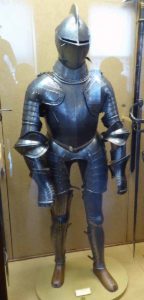
Suit of Armour in the Wallace Collection: First Battle of St Albans, fought on 22nd May 1455 in the Wars of the Roses
Follow-up to the First Battle of St Albans: After the battle, the Duke of York made his way to London with the King, effectively his prisoner. While confirming his loyalty to King Henry VI, the Duke of York caused a Parliament to meet and bestow the offices of state on his own supporters.
This situation continued until the end of 1456, when the Queen, Margaret of Anjou, regained the ascendancy and caused the Duke of York and his party to lose their positions.
Anecdotes and traditions from the First Battle of St Albans:
- While the Yorkists prepared for battle on arrival in the Key Fields, the King’s retinue placed their faith in settling the claims of the Duke of York, the Earl of Salisbury and the Earl of Warwick, by negotiation. By the time the Yorkists launched their attack, few in the King’s retinue were ready and many were caught by Warwick’s incursion into Hollowell Street still putting on their armour.
- It is said that the Duke of Somerset was warned by a sooth sayer that he would die in the shadow of a castle. From then on Somerset kept away from castles. With the successful attack by the Yorkists, Somerset took refuge in the Castle Inn without knowing what the building was called. Once he saw the inn sign, Somerset realised that it was all up with him. He burst into the street and fought fiercely until he was cut down by Yorkist soldiers.
- The Royal Standard was an important symbol for the King’s men. Sight of the standard made it clear to all in the opposing army that they were in rebellion against the King, when they might not have known this. The standard was not easily to be seen in the attack on the town. It is suggested that no trouble was taken to ensure that the Royal Standard was clearly displayed and that it was found at the end of the battle leaning against a wall.
- The First Battle of St Albans was the backdrop for William Shakespeare’s Henry VI Part 2, Act V, Scenes II, III and IV. Shakespeare incorporates Queen Margaret into his play, while she was not in fact present, being left with the Prince of Wales at Greenwich.
Emblems and War Cries at the First Battle of St Albans:
- The men in Warwick’s party shouted the war cry ‘á Warwick’ (‘for Warwick’ in French) as they attacked. At a time when there was little or no standardisation in battle costume, particularly for the ordinary soldiers, the wearing of an emblem and the shouting of a common war cry identified the side the soldier was on. It often intimidated the enemy.
- The Earl of Warwick’s emblem was the Bear on the Ragged Staff, still the emblem of the County of Warwickshire.
- After the First Battle of St Albans, the Duke of York and the Earl of Warwick built a chantry chapel in London, where a priest prayed daily for the souls of those killed in the battle.
References for the First Battle of St Albans:
First Battle of St Albans by Andrew Boardman
Battles of St Albans by Peter Burley, Michael Elliott and Harvey Watson
Wars of the Roses by Michael Hicks
Chronicles of the Wars of the Roses
British Battles by Grant
Battles in Britain 1066-1746 by William Seymour
The previous battle of the Hundred Years War is the Battle of Castillon
The next battle of the Wars of the Roses is the Battle of Blore Heath
to the Wars of the Roses Index
